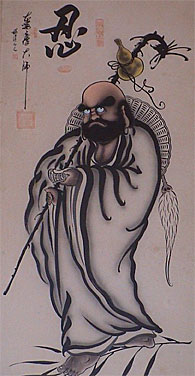|
Damo introduced Qi-Gong exercises to the Chinese monks and it is from Damo that the breathing techniques of Wuzu are derived. An Indian monk who travelled from India to Guangzhou (Canton) in 520, and thence by foot to Song Mountain Henan, where he settled in the Shaolin Temple (then hardly a century old): Damo (Bodhidarma) was the 28th Patriarch of Buddhism and the First Patriarch of Chan (Zen) Buddhism.
At the Temple he found the monks in poor health, hardly able to carry out their important spiritual duties. At the end of his famous nine year long meditation (carried out in a cave to the rear of the Temple) he realised that his long period of sitting had atrophied his leg muscles to the point of immobility. He sought a remedy to this problem (and fortuitously to that of the health condition of his fellow monks as well) through specially devised breath control exercises, combined with meditation (mind-intent).
Through these excercises his mobility was progressively regained and his vitality greatly increased, for he had generated and directed his qi through the qi-gong exercises he had discovered. These, he taught the monks, who were not only swiftly restored to good health and gained great powers of concentration, but also found aspects of the system could be used in self-defence.
Damo is reputedly the creator of the 18 Lohan Hand Forms. He pursued his travels once again having taught the monks Ch’an Buddhism. He inspired the writing of two famous books, The ‘I Chin Ching/ I Jin Jing’ (The Sinew Change Classic), and the ‘Sui King Chin/Sui King Jin’ (Washing Marrow Classic): both teach the meditation and respiratory techniques for developing the Qi and hand movements.
|
